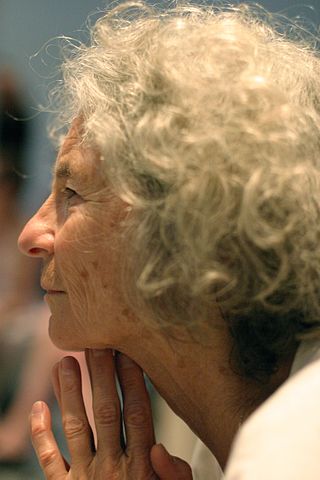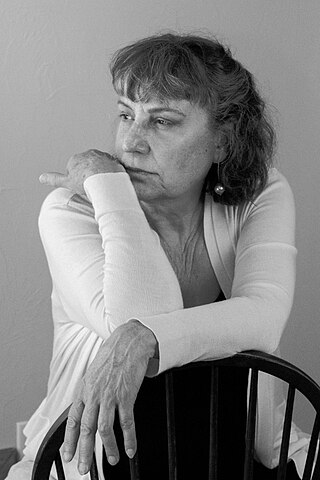Related Research Articles

Improvisational theatre, often called improvisation or improv, is the form of theatre, often comedy, in which most or all of what is performed is unplanned or unscripted, created spontaneously by the performers. In its purest form, the dialogue, action, story, and characters are created collaboratively by the players as the improvisation unfolds in present time, without use of an already prepared, written script.
Improvisation, often shortened to improv, is the activity of making or doing something not planned beforehand, using whatever can be found. The origin of the word itself, is in the Latin 'improvisus', which literally means un-foreseen. But it is also related to both the old French word 'emprouer' and the English 'improve', to improve. Improvisation in the performing arts is a very spontaneous performance without specific or scripted preparation. The skills of improvisation can apply to many different faculties, across all artistic, scientific, physical, cognitive, academic, and non-academic disciplines; see Applied improvisation.
Freestyle is a style of improvisation, with or without instrumental beats, in which lyrics are recited with no particular subject or structure and with no prior memorization. It is similar to other improvisational music, such as jazz, where a lead instrumentalist acts as an improviser with a supporting band providing a beat. Freestyle originally was simply verse that is free of style, written rhymes that do not follow a specific subject matter, or predetermined cadence. The newer style with the improvisation grew popular starting in the early 1990s. It is now mainly associated with hip hop.
Contact improvisation is a form of improvised partner dancing that has been developing internationally since 1972. It involves the exploration of one's body in relationship to others by using the fundamentals of sharing weight, touch, and movement awareness. It has evolved into a broad global community of social dancing around "jams" characterized by their welcoming attitude towards newcomers to dance, as well as seasoned practitioners, and is often found overlapping with ecstatic dance communities.
Dance improvisation is the process of spontaneously creating movement. Development of movement material is facilitated through a variety of creative explorations including body mapping through levels, shape and dynamics schema.
Judson Dance Theater was a collective of dancers, composers, and visual artists who performed at the Judson Memorial Church in Greenwich Village, Manhattan New York City between 1962 and 1964. The artists involved were avant garde experimentalists who rejected the confines of Modern dance practice and theory, inventing as they did the precepts of Postmodern dance.

Yvonne Rainer is an American dancer, choreographer, and filmmaker, whose work in these disciplines is regarded as challenging and experimental. Her work is sometimes classified as minimalist art. Rainer currently lives and works in New York.

Steve Paxton is an experimental dancer and choreographer. His early background was in gymnastics while his later training included three years with Merce Cunningham and a year with José Limón. As a founding member of the Judson Dance Theater, he performed works by Yvonne Rainer and Trisha Brown. He was a founding member of the experimental group Grand Union and in 1972 named and began to develop the dance form known as Contact Improvisation, a form of dance that utilizes the physical laws of friction, momentum, gravity, and inertia to explore the relationship between dancers.

Maggie Nicols, is a Scottish free-jazz and improvising vocalist, dancer, and performer.

David Gordon was an American dancer, choreographer, writer, and theatrical director prominent in the world of postmodern dance and performance. Based in New York City, Gordon's work has been seen in major performance venues across the United States, Europe, South America and Japan, and has appeared on television on PBS's Great Performances and Alive TV, and the BBC and Channel 4 in Great Britain.

Oui Be Negroes is an African-American improvisational sketch comedy ensemble, founded by Artistic Director Shaun Landry and Director Hans Summers. They worked together for many years in Chicago with the Underground Theatre Conspiracy, and had thrown around the idea of an African-American-driven sketch and improvisational comedy troupe, which would be geared specifically toward social and political humor.

Simone Forti, is an American Postmodern artist, dancer, choreographer, and writer. Since the 1950s, Forti has exhibited, performed, and taught workshops all over the world. Her innovations in Postmodern dance, including her seminal 1961 body of work, Dance Constructions, along with her contribution to the early Fluxus movement, have influenced many notable dancers and artists. Forti first apprenticed with Anna Halprin in the 1950s and has since worked alongside artists and composers Nam June Paik, Steve Paxton, La Monte Young, Trisha Brown, Charlemagne Palestine, Peter Van Riper, Dan Graham, Yoshi Wada, Robert Morris and others. Forti's published books include Handbook in Motion, Angel, and Oh Tongue. She is currently represented by The Box L.A. in Los Angeles, CA, and has works in the permanent collections of the Museum of Modern Art (MOMA) in New York, the Stedelijk Museum in Amsterdam, the Generali Foundation in Vienna, the Whitney Museum of American Art in New York, and the Moderna Museet in Stockholm.
Robert Alexander was born in Brooklyn, New York, United States, on the November 21, 1943. He spent most of his early life there, eventually working as a freelance photographer and photographer's assistant from various addresses, including Remsen Street in the downtown area of the city. Alexander studied Art History at the University of Pennsylvania from 1961 to 1965, and conducted brief stints at both the New School for Social Research and the School of Visual Arts. By the early seventies, Alexander had moved to Manhattan and had begun his work as a freelance photographer; although he continued to assist other photographers for several years. He also worked as a commercial photographer, contributing to catalogues and advertising for jewelry and clothing manufacturers.
Robert Ellis Dunn was an American musician and choreographer who led classes in dance composition, contributing to the birth of the postmodern dance period in the early 1960s in New York City.
Valda Setterfield was a British-born American postmodern dancer and actress. She was noted for her work as a soloist with the Merce Cunningham Dance Company and for her performances in works by her husband, postmodern choreographer and director David Gordon. She was described as his muse, and together they were called "The Barrymores of post-modern dance." Their son, playwright, theatrical director and actor Ain Gordon, has worked with Setterfield on a number of projects as well.
The physically integrated dance movement is part of the disability culture movement, which recognizes and celebrates the first-person experience of disability, not as a medical model construct but as a social phenomenon, through artistic, literary, and other creative means.

James Waring was a dancer, choreographer, costume designer, theatre director, playwright, poet, and visual artist, based in New York City from 1949 until his death in 1975. He was a prolific choreographer and teacher. He has been called "one of the most influential figures in the New York avant-garde in the late fifties and early sixties", "one of dance's great eccentrics", "a focal point for dance experimentation before the existence of the Judson Dance Theater", and "the quintessential Greenwich Village choreographer in the late 1950s and 1960s". Waring's collage style of building dance works influenced the development of the avant-garde Happenings which were staged in the late 1950s.

Ishmael Houston-Jones is a choreographer, author, performer, teacher, curator, and arts advocate known for his improvisational dance and language work. His work has been performed in New York City, across the United States, in Europe, Canada, Australia and Latin America. Houston-Jones and Fred Holland shared a 1984 New York Dance and Performance Bessie Award for their work Cowboys, Dreams and Ladders performed at The Kitchen and he shared another Bessie Award in 2011 with writer Dennis Cooper and composer Chris Cochrane for the 2010 revival of their 1985 collaboration, THEM. THEM was performed at Performance Space 122, the American Realness Festival, Springdance in Utrecht, Tanz im August in Berlin, REDCAT in Los Angeles, Centre Pompidou in Paris, and at TAP, Theatre and Auditorium of Poitiers, France. The 1985 premier performance of THEM at PS122 was part of New York's first AIDS benefit.
Barbara Dilley (Lloyd) (born 1938) is an American dancer, performance artist, improvisor, choreographer and educator, best known for her work as a prominent member of the Merce Cunningham Dance Company (1963-1968), and then with the groundbreaking dance and performance ensemble The Grand Union, from 1969 to 1976. She has taught movement and dance at Naropa University in Boulder, Colorado, since 1974, developing a pedagogy that emphasizes what she calls “embodied awareness,” an approach that combines dance and movement studies with meditation, “mind training” and improvisational composition. She served as the president of Naropa University from 1985 to 1993.

Mary Overlie was an American choreographer, dancer, theater artist, professor, author, and the originator of the Six Viewpoints technique for theater and dance. The Six Viewpoints technique is both a philosophical articulation of postmodern performance and a teaching system addressing directing, choreographing, dancing, acting, improvisation, and performance analysis. The Six Viewpoints has been taught in the core curriculum of the Experimental Theater Wing within Tisch School of the Arts at New York University since its inception (1978).
References
- Notes
- ↑ Novack, Cynthia Jean (1990). Sharing the dance : contact improvisation and American culture. Madison, Wis.: University of Wisconsin Press. ISBN 978-0-299-12443-4. OCLC 645301122.
- ↑ Rainer, Yvonne. Feelings are Facts, chapter 14
- 1 2 3 Gordon, David. Remarks made during the "Collaboration: Investigating New Forms" session at the Theatre Communications Group National Conference in June 1982. Published in "TCG Focus: Combining Forces" in Theatre Communications (January 1983)
- ↑ Rainer, Yvonne. Feelings are Facts, pg. 335
- Further reading
- Ramsay, Margaret Hupp. The Grand Union (1970-1976): An Improvisational Performance Group. New York: Peter Lang, 1991.